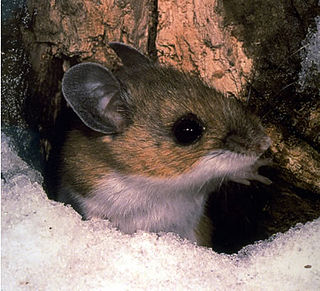Schmidly's deer mouse, is a recently described species of deer mouse from the mountains of western Mexico. It is part of the highly complex and well-studied Peromyscus boylii species complex. The uniqueness of Peromyscus from this area had long been suspected, but was only formalized in 2004 with the publication of its species description. The species was named in honor of David J. Schmidly, a mammalogist and former president of the University of New Mexico.

The Neotominae are a subfamily of the family Cricetidae. They consist of four tribes, 16 genera, and many species of New World rats and mice, predominantly found in North America. Among them are the well-known deer mice, white-footed mice, packrats, and grasshopper mice.
Cerradomys marinhus, also known as Marinho's rice rat, is a rodent species from South America. It is found in Minas Gerais, Brazil. It was formerly known as Oryzomys marinhus, but was transferred to the new genus Cerradomys in 2006.
Oecomys paricola, also known as the Brazilian oecomys, Brazilian arboreal rice rat, or South Amazonian arboreal rice rat, is a species of rodent in the genus Oecomys of family Cricetidae. It is found in central Brazil south of the Amazon, where it lives in lowland tropical rainforest.
Nesoryzomys indefessus, also known as the Santa Cruz nesoryzomys or Indefatigable Galápagos mouse, is a rodent of the genus Nesoryzomys of family Cricetidae from Galápagos Islands of Ecuador. It contains two subspecies: one formerly lived on Santa Cruz Island, but is now extinct, probably due to the introduction of black rats; and another that is still alive on Fernandina Island. The two are sometimes considered to be different species.
The inland hill rat is a species of rodent in the family Muridae. It is found only in central and southern Sulawesi, Indonesia.
The Chinanteco deer mouse is a species of rodent in the family Cricetidae. It is endemic to Mexico.
The Jico deer mouse is a species of rodent in the family Cricetidae found only in Mexico. Its natural habitat is subtropical or tropical moist lowland forests.
Melanomys zunigae, also known as Zuniga's melanomys or Zuniga's dark rice rat, is a species of rodent in the genus Melanomys of family Cricetidae. Known only from a small region of coastal Peru, it is listed as "critically endangered" by the IUCN and may even be extinct.
The Somali pygmy gerbil is a species of rodent in the family Muridae. It is the only species in the genus Microdillus. It is found only in Somalia. Its natural habitat is subtropical or tropical dry shrubland.
Neacomys pictus, also known as the painted neacomys or painted bristly mouse, is a species of rodent in the genus Neacomys of family Cricetidae. It is found only in Panama.
Handleyomys rhabdops, also known as the highland oryzomys or striped rice rat, is a species of rodent in the genus Handleyomys of family Cricetidae. It is nocturnal and is found in Guatemala and Mexico in montane forest at elevations from 1250 to 3250 m.
The Ixtlán deer mouse is a species of rodent in the family Cricetidae.
Nectomys grandis, also known as the Magdalena-Cauca water rat, is a nocturnal, semiaquatic species of rodent in the genus Nectomys of family Cricetidae. It is found in western and northern Colombia at altitudes from sea level to 2000 m, including the basins of the Magdalena, Cauca and Porce rivers. It has two subspecies, N. g. grandis and N. g. magdalenae.
Oligoryzomys brendae, also known as Brenda's colilargo, is a South American species of rodent in the genus Oligoryzomys. It is found only in Tucumán Province in northwestern Argentina, but its taxonomic status requires revision.
Hylaeamys tatei, also known as Tate's oryzomys or Tate's rice rat, is a South American rodent species of the family Cricetidae. It is known only from the eastern foothills of the Andes in central Ecuador, where it has been found at elevations from 1130 to 1520 m. H. tatei is most closely related to H. yunganus, which occurs throughout Amazonia. The species is found in tropical rainforest and is terrestrial and probably nocturnal. It is named after American zoologist George Henry Hamilton Tate.
Habromys schmidlyi, sometimes known as Schmidly's deer mouse, is a species of rodent in the family Cricetidae found only in Mexico. Its natural habitat is cloud forest in the Sierra de Taxco, on the border of Guerrero and Mexico states, above 1,800 meters elevation.

